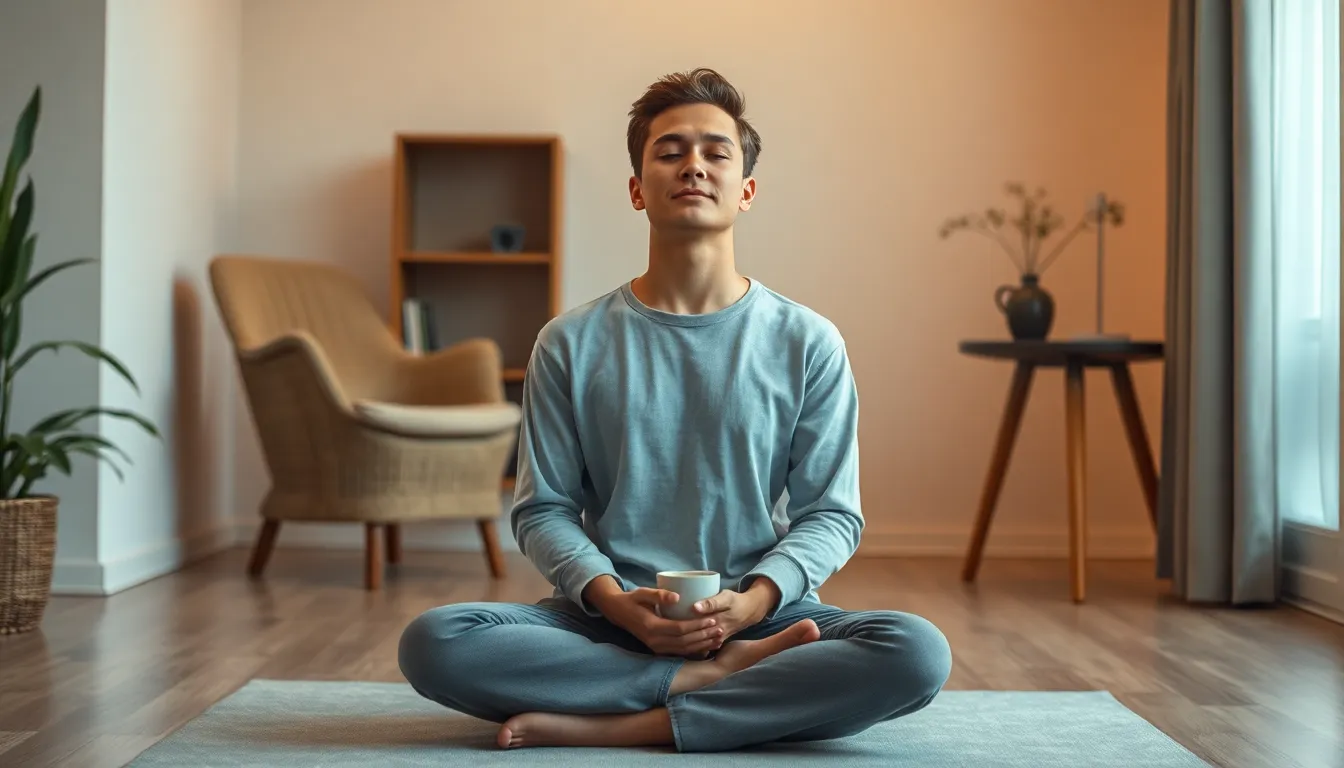Table of Contents
ToggleIn a world buzzing with distractions, finding a moment of peace can feel like searching for a needle in a haystack. But fear not! This beginner mindfulness guide is here to help even the busiest bees cultivate a little calm amidst the chaos. Imagine sipping your morning coffee without checking your phone every five seconds—sounds dreamy, right?
Mindfulness isn’t just for yogis in flowing robes; it’s a superpower anyone can harness. With simple techniques and a sprinkle of humor, this guide will turn the daunting task of being present into a delightful adventure. So, whether you’re a seasoned overthinker or just trying to dodge life’s daily stressors, it’s time to embrace the art of mindfulness and discover how to savor every moment like it’s the last slice of pizza.
Understanding Mindfulness
Mindfulness cultivates awareness and presence amid daily chaos. It involves focusing on the present moment without judgment, allowing individuals to experience their thoughts, feelings, and surroundings more consciously.
Definition of Mindfulness
Mindfulness signifies the practice of being fully engaged in the current experience. This concept, rooted in ancient Buddhist traditions, emphasizes non-judgmental observation of thoughts and sensations. Practitioners acknowledge their feelings and thoughts without attachment or aversion, promoting a state of clarity. Many novices discover mindfulness through simple activities like breathing exercises that anchor them in the now.
Benefits of Practicing Mindfulness
Practicing mindfulness enhances emotional regulation and decreases stress. Research shows regular mindfulness can improve concentration and promote overall well-being. Some individuals notice better sleep quality as they cultivate relaxation through mindful techniques. Others find significant improvements in relationships due to increased empathy and understanding. Engaging in mindfulness leads to greater resilience when facing challenges, revealing its multifaceted advantages.
Getting Started with Mindfulness

Mindfulness begins with a commitment to presence. Practitioners should create an inviting atmosphere that supports their practice.
Preparing Your Mind and Space
A conducive space enhances mindfulness. Choose a quiet area free from distractions. Soft lighting and comfortable seating promote relaxation. Prepare the mind by focusing on breathing. Inhale deeply, then exhale slowly. This simple exercise reduces immediate stress. Regular practice yields greater awareness over time. Engaging in mindfulness during daily tasks, like drinking coffee or walking, cultivates an ongoing connection to the present moment.
Setting Realistic Expectations
Mindfulness isn’t a quick fix but rather a gradual process. Beginners might face challenges, such as a wandering mind. Acknowledge these thoughts without judgment. Progress unfolds at individual paces. Celebrate small victories instead of striving for perfection. Set aside a few minutes daily, gradually increasing the duration. Consistency reinforces the practice. Mindfulness isn’t about immediate results; it’s about nurturing a deeper connection to oneself. Embrace the journey and allow growth to happen organically.
Mindfulness Techniques for Beginners
Practicing mindfulness involves several techniques that can be easily integrated into daily life. Each method offers unique ways to enhance awareness and presence amidst distractions.
Breathing Exercises
Breathing exercises serve as a foundational practice in mindfulness. Focus on deep, slow breaths, inhaling through the nose and exhaling through the mouth. Practitioners may find it beneficial to count breaths, allowing thoughts to fade into the background. Begin with a few minutes daily, gradually extending to longer sessions. Observing how the breath feels can create a calming effect, grounding individuals in the present moment. Such exercises reduce stress, enhance emotional regulation, and improve concentration over time.
Body Scan Meditation
Body scan meditation encourages awareness of physical sensations throughout the body. Starting from the toes and moving upward, individuals observe tension and relaxation in each area. This technique promotes non-judgmental awareness, helping practitioners connect with their bodies. While scanning, it’s important to maintain slow, intentional breaths. Beginners may find comfort in guided recordings to facilitate this practice. Over time, the body scan enhances mindfulness and fosters a deeper understanding of bodily sensations and emotional states.
Mindful Walking
Mindful walking transforms everyday activity into a meditative practice. Focus on the sensations of each step, noticing how feet touch the ground and the rhythm of movement. Walking outdoors can amplify the experience, allowing participants to observe the surrounding environment. Practitioners should notice the sounds, smells, and sights without distraction. Engaging with nature while walking promotes relaxation and reinforces presence. With consistent practice, mindful walking deepens the connection between body and mind, enhancing overall well-being.
Incorporating Mindfulness into Daily Life
Mindfulness can seamlessly blend into daily habits, enhancing everyday experiences.
Mindfulness in Routine Activities
Engaging in routine activities mindfully transforms mundane tasks into meaningful moments. Eating lunch requires attention; savoring each bite increases appreciation for food. When washing dishes, focus on the warmth of water and the texture of utensils. Practitioners can find peace in commuting; observing surroundings minimizes stress and encourages presence. People can also enhance mindfulness during conversations by fully listening without distraction. Each activity invites opportunity for awareness, creating a daily practice effortlessly.
Creating a Mindfulness Schedule
Establishing a mindfulness schedule cultivates consistency in practice. Start by allocating specific times for mindfulness activities, such as morning meditation or evening reflections. Scheduling reminders on phones or calendars keeps practitioners accountable. Including short breaks throughout the day for deep breathing allows moments of calm amid busyness. Weekends can feature longer sessions, allowing deeper exploration of mindfulness techniques. Balance structured practices with spontaneous moments, such as pausing to appreciate nature during a walk. Each mindful moment strengthens the overall practice, leading to greater awareness in daily life.
Embracing mindfulness opens the door to a more fulfilling life. It encourages individuals to carve out moments of tranquility in their busy schedules. By practicing simple techniques and integrating mindfulness into daily routines, anyone can cultivate a deeper sense of awareness and presence.
The journey may come with challenges but celebrating small victories makes it worthwhile. With patience and consistency, mindfulness can transform everyday activities into profound experiences. As individuals nurture their connection to themselves, they’ll discover the resilience needed to navigate life’s ups and downs. Mindfulness isn’t just a practice; it’s a pathway to a richer, more meaningful existence.







